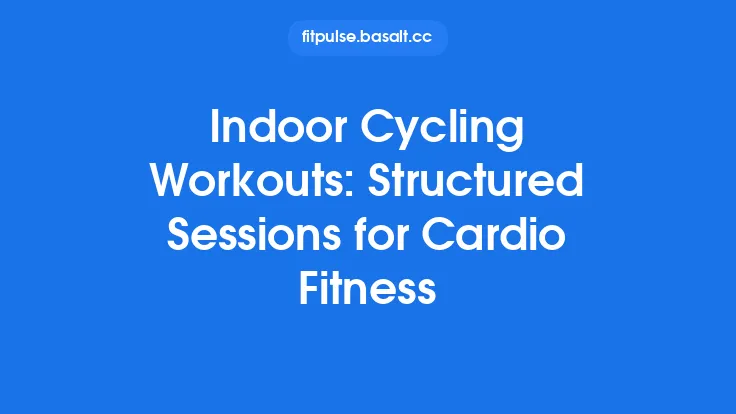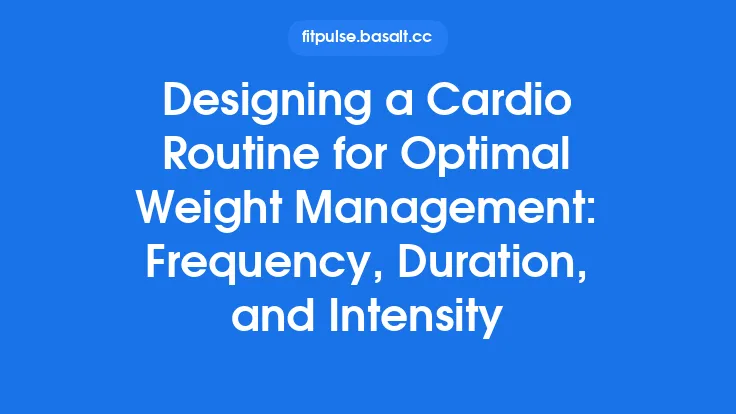The modern lifestyle often leaves us with fragmented pockets of time, yet the desire for a vigorous cardio workout remains strong. A 15‑minute high‑intensity session can deliver substantial cardiovascular benefits, calorie burn, and metabolic uplift without demanding a large time commitment or extensive equipment. Below is a comprehensive guide that walks you through the science, structure, and practical execution of an “Express Cardio” routine you can perform at home, anytime the schedule permits.
The Science Behind 15‑Minute High‑Intensity Cardio
Energy Systems in Play
During a short, intense bout of exercise, the body primarily relies on the phosphagen (ATP‑CP) system for the first 10‑15 seconds, followed by a rapid shift to anaerobic glycolysis. As the interval progresses beyond 30 seconds, the aerobic system begins to dominate, especially during brief recovery periods. This seamless transition maximizes oxygen consumption (VO₂) and stimulates the afterburn effect—known as excess post‑exercise oxygen consumption (EPOC)—which can elevate calorie expenditure for up to several hours after the session ends.
Physiological Adaptations
Consistently performing 15‑minute high‑intensity cardio sessions can lead to:
- Improved VO₂ max – the gold standard for aerobic capacity.
- Enhanced lactate threshold – allowing you to sustain higher intensities before fatigue sets in.
- Increased mitochondrial density – boosting the muscles’ ability to generate ATP aerobically.
- Cardiovascular remodeling – including lower resting heart rate and improved stroke volume.
These adaptations are not exclusive to long-duration workouts; the intensity factor compensates for the reduced time, making the routine both efficient and effective.
Choosing the Right Space and Minimal Equipment
| Requirement | Details |
|---|---|
| Flooring | A non‑slippery surface such as a yoga mat, hardwood, or carpet. |
| Space | Approximately 2 × 2 m (6.5 × 6.5 ft) to allow full range of motion for jumps and lateral moves. |
| Equipment | Optional: a sturdy chair or low bench, a jump rope, and a timer (smartphone or interval app). No dumbbells or resistance bands are needed for the core cardio moves. |
| Safety | Clear the area of breakable objects, ensure adequate ventilation, and have a water bottle within reach. |
Warm‑Up: Preparing the Body for Intensity (3 Minutes)
A focused warm‑up raises core temperature, activates the neuromuscular system, and reduces injury risk. Perform each movement for 30 seconds, transitioning smoothly from one to the next:
- Dynamic March with Arm Swings – Elevate the knees to hip height while swinging opposite arms forward and back.
- Leg Swings (Front‑to‑Back) – Hold onto a wall or chair for balance; swing each leg forward and backward.
- Hip Circles – Place hands on hips and rotate clockwise for 15 seconds, then counter‑clockwise.
- High‑Knee Skips – Lightly skip in place, driving knees upward and pumping arms.
- Arm Circles – Small to large circles, forward then backward, to mobilize shoulder joints.
Finish the warm‑up with a brief, controlled breath: inhale for 2 counts, exhale for 2 counts, to center focus.
The Express Cardio Routine (12 Minutes)
The session follows a 30‑seconds work / 15‑seconds rest interval structure, totaling eight rounds. Each round pairs two complementary movements that target different muscle groups, allowing partial recovery while maintaining overall intensity.
| Round | Work (30 s) | Rest (15 s) | Work (30 s) | Rest (15 s) |
|---|---|---|---|---|
| 1 | Jumping Jacks – Full‑body cardio, arms and legs moving in sync. | – | Mountain Climbers – Core‑stabilized, rapid knee drives. | – |
| 2 | High‑Knee Runs – Drive knees to chest, pump arms. | – | Squat Jumps – Explosive lower‑body power, land softly. | – |
| 3 | Alternating Lateral Bounds – Side‑to‑side hops, land on one foot. | – | Burpee‑to‑Plank – Full‑body, focus on quick transition. | – |
| 4 | Fast Feet Shuffle – Quick steps laterally, stay light on toes. | – | Skater Hops – Diagonal jumps, crossing rear leg behind. | – |
Execution Tips
- Intensity Cue: Aim for a perceived exertion of 8–9 on a 10‑point scale (hard but sustainable for the 30‑second work interval). Use a metronome or music with a 150–170 BPM tempo to keep pace.
- Form Focus: Keep the core braced, shoulders relaxed, and land with soft knees to absorb impact.
- Progression: If 30 seconds feels too long, start with 20 seconds work / 20 seconds rest, then gradually shift to the full 30/15 scheme.
Scaling the Routine for Different Fitness Levels
| Goal | Modification |
|---|---|
| Beginner | Reduce work interval to 20 seconds, increase rest to 30 seconds. Substitute high‑impact moves (e.g., squat jumps) with low‑impact alternatives (e.g., bodyweight squats). |
| Intermediate | Maintain 30/15 structure, add a light weighted vest (2–5 kg) for added resistance. |
| Advanced | Incorporate plyometric variations (e.g., tuck jumps, double‑unders with a jump rope) and shorten rest to 10 seconds. |
| Endurance Focus | Extend the session to 16 minutes by adding two extra rounds, keeping the same interval ratio. |
Cool‑Down and Recovery (2 Minutes)
A brief cool‑down facilitates heart‑rate normalization and promotes flexibility. Perform each stretch for 30 seconds, breathing deeply:
- Standing Quad Stretch – Pull heel toward glutes, keep knees aligned.
- Chest Opener – Interlace fingers behind back, lift arms gently.
- Seated Forward Fold – Extend legs, hinge at hips, reach toward toes.
Finish with a 30‑second diaphragmatic breathing exercise: inhale through the nose for 4 counts, hold 2, exhale through the mouth for 6 counts.
Tracking Progress and Measuring Success
- Heart‑Rate Monitoring: Use a chest strap or optical sensor to record average heart rate (HR) and peak HR during each session. Aim for 80–90 % of your age‑predicted maximum HR (220 – age) for optimal stimulus.
- RPE Log: Note the perceived exertion after each round. A decreasing RPE over weeks indicates improved conditioning.
- Performance Metrics: Record the number of repetitions completed per 30‑second work interval. Incremental gains (e.g., +5 reps per round) reflect enhanced power and efficiency.
- Recovery Indicators: Track resting heart rate each morning; a gradual decline suggests positive adaptation.
Common Mistakes and How to Avoid Them
| Mistake | Why It’s Problematic | Corrective Action |
|---|---|---|
| Neglecting the Warm‑Up | Increases risk of muscle strains and reduces performance. | Allocate at least 3 minutes to dynamic movements before the first interval. |
| Over‑extending Rest Periods | Lowers cardiovascular stimulus, diminishing EPOC. | Use a timer or interval app to enforce precise 15‑second rests. |
| Poor Landing Mechanics | Excessive joint stress, especially on knees and ankles. | Land softly with knees slightly bent, distribute impact through the entire foot. |
| Holding Breath | Reduces oxygen delivery, accelerates fatigue. | Practice rhythmic breathing—inhale during the less demanding phase of a movement, exhale during exertion. |
| Skipping Cool‑Down | Can cause blood pooling and delayed-onset muscle soreness (DOMS). | Dedicate at least 2 minutes to static stretching and deep breathing. |
Safety Considerations
- Medical Clearance: Individuals with cardiovascular conditions, hypertension, or joint issues should consult a healthcare professional before initiating high‑intensity cardio.
- Surface Choice: Avoid overly hard floors (concrete) without cushioning; they increase impact forces on the skeletal system.
- Hydration: Sip water before and after the session; dehydration can impair performance and increase perceived exertion.
- Footwear: Wear supportive, low‑profile shoes that allow natural foot movement while providing shock absorption.
Final Thoughts
A 15‑minute high‑intensity cardio session is a powerful tool for anyone seeking to boost cardiovascular health, burn calories, and improve metabolic efficiency without sacrificing precious time. By understanding the underlying physiology, adhering to a structured interval format, and applying progressive overload principles, you can turn a brief home workout into a cornerstone of long‑term fitness. Consistency, proper technique, and mindful recovery will ensure that each Express Cardio session not only fits seamlessly into a busy schedule but also delivers lasting, evergreen benefits for health and performance.





